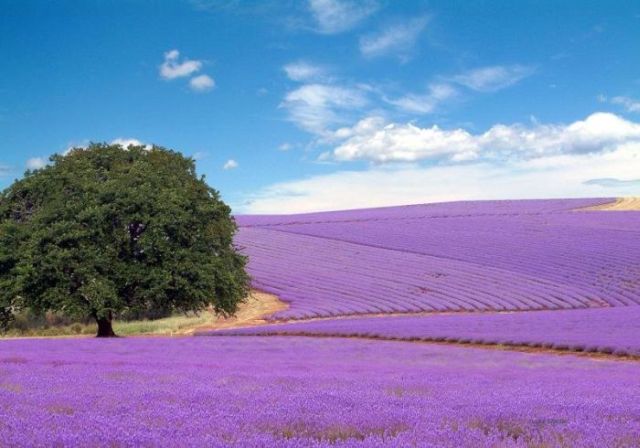My New Happy Place
This morning I received an email from a friend with pictures from a lavender ranch in Texas. This last photo instantly became my new happy place. Is it the incredible wave of purple? The intense blue of the sky? The contrast? The aroma I imagine when I breathe deeply and close my eyes remembering the scene? The warmth I feel as I lift my face to the envisioned sun? The quietly persistent bee buzzing I hear in the field in my mind? Being alone in the middle of it all?
More importantly, what is the function of a happy place and why do I need one?
To answer those questions, I have to go back to my first happy place: a red farm house in the woods where the kids were chasing ducks around. It was a starving artists' painting hanging at my neighbor's house. I recalled it when I was in the hospital having my fractured left elbow set. Instead of focusing on the drilling of a metal rod through my skin and into my bones to hold them together, I thought about running around with the farm kids in the sunlight. Later, it was the more surreal carousel in Mary Poppins that held my attention when I had to have my appendix taken out. I needed to distract my mind away from the nervousness and pain. There was no need to dwell on the things I could not change. I needed to find a way to get through them. A few quick trips to my happy places helped me to focus on the calm, quiet, and positive and get through the necessary procedures.
A happy place is the distracting scene one offers one's mind to play in temporarily while real-time sensory data is causing a serious disturbance in one's ability to respond with reason. One goes there when one needs to relax or focus on happy thoughts in order to reset and better grasp the reality of the unpleasant situation.
In my thirties, my happy place was riding a horse through an apple orchard in bloom, but these days I'd prefer to walk through fields of lavender (with or without a shirtless Hugh Jackman as the lavender farmer).
Significantly, going to happy places differs from evasion in that you are purposefully using the technique to assist you in dealing with reality. Let's face it: sometimes, things suck and you may find yourself with little or no control over a situation, but need to find a way through it. A quick trip to a happy place can help remind you that you do have the power to be happy.
An activity related to, but separate in function from visiting happy places, is collecting moments of peaceful satisfaction or extreme happiness. This activity, like the construction of a vision board, helps you better define and focus on your joy. As an adult, I started to collect these moments as I was experiencing them. I began to appreciate what brought me joy and how I wanted to understand and feed the ability to feel that way as it was occuring, not merely as an afterthought.
This was reality, she thought, this sense of clear outlines, of purpose, of lightness, of hope. This was the way she had expected to live--she had wanted to spend no hour and take no action that would mean less than this.Ayn Rand, Atlas Shrugged
While Dagny's defining moment of joy in sharing with Hank a quiet appreciation of Rearden metal is clearly linked to her purpose in life, and, I'll admit, my purpose in life is less defined by me at this point, I would argue that appreciating what makes me happy is the first step in helping me to take actions which lead to the way I expect to live - happily.
Rather than running from reality, my brief visits to the fantastic assist me in addressing reality in some situations and in living joyously in others, as my real-life lavender farmer can attest.


Comments
Secondly, the function of a Happy Place reminds me of the spell "Expecto Patronum" from Harry Potter...the wizard or witch uses the happiest, most joyous memory or thought (a Happy Place!) and uses that power (with a magic wand, of course) as not just a way to deal with something awful (Dementors, who suck the happiness--and life--out of you), but as an actual ward against it.
In the absence of real magic, a Happy Place will have to do. :)
Plus this particular happy place is exceptionally beautiful. :) Thanks for sharing it.
The ocean beach does it for me. When we are on the Cape I go down early early in the morning to just sit and breathe.
As Michael said above, when I was going through chemo my happy place was indispensable.
http://www.jensart.com/_08images/08D037_lavender-summer-2-provence-france-lavender-paintings.php
http://www.jensart.com/_images/05B028.php
http://www.jensart.com/main_view_paintings.php